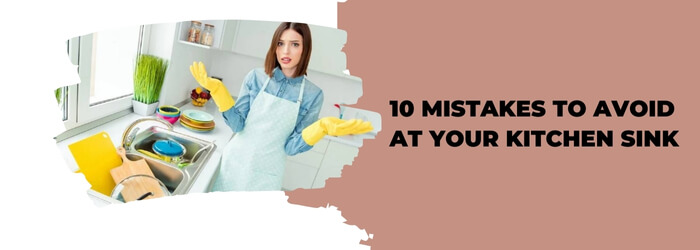Kitchen Sink
10 Mistakes to Avoid at Your Kitchen Sink
10 Mistakes to Avoid at Your Kitchen Sink
The kitchen sink is undoubtedly one of the most frequently used areas in your kitchen. It’s not only a functional space for dishwashing and food preparation but also a focal point for the entire kitchen. However, despite its importance, many people make common mistakes when it comes to their kitchen sink. In this blog post, we’ll explore the top 10 mistakes to avoid at your kitchen sink to ensure it remains a functional and aesthetically pleasing part of your kitchen.
- Neglecting Regular Cleaning
One of the most common mistakes people make is neglecting regular cleaning of their kitchen sink. Over time, food particles, soap scum, and mineral deposits can build up, leading to an unsightly and unhygienic sink. To avoid this, make it a habit to clean your sink regularly using mild detergents and a soft cloth or sponge.
- Using the Wrong Cleaning Products
Using harsh chemicals or abrasive scouring pads can damage your sink’s finish. Stick to gentle, non-abrasive cleaning products to maintain the sink’s appearance. Baking soda and white vinegar are natural alternatives that work wonders for sink cleaning.
- Overloading the Sink
Another common mistake is overloading the sink with too many dishes. This can strain the sink and the plumbing, potentially causing leaks or damage. To avoid this, try to do the dishes in smaller batches rather than piling them up.
- Ignoring Clogs
Clogs in the kitchen sink are a common issue, often caused by food scraps, grease, and soap residue. Ignoring clogs can lead to slow drainage or even more severe plumbing problems. Use a sink strainer to catch food particles and address clogs promptly with a plunger or a drain snake.
- Neglecting the Garbage Disposal
If your sink has a garbage disposal unit, it requires proper care. Many people forget to use it or fail to maintain it. Regularly run the disposal with cold water to prevent odors and clogs, and avoid putting items like bones, coffee grounds, or fibrous vegetables down the disposal.
- Using Hot Water on Greasy Dishes
Hot water might seem like the best choice for greasy dishes, but it can cause grease to solidify in your pipes, leading to clogs. Instead, use cold water when dealing with greasy items, and ensure you have an effective grease-trapping system.
- Leaving Metal Objects in the Sink
Leaving metal objects like knives or utensils in the sink can not only damage your sink’s finish but also pose a safety hazard. Always place these items in a designated holder or in a dish rack.
- Stacking Wet Dishes
Stacking wet dishes in your sink can trap moisture and create an ideal breeding ground for mold and mildew. It’s best to let dishes air dry on a dish rack to prevent this issue.
- Neglecting the Faucet
Your faucet plays a crucial role in the functionality and appearance of your sink. Neglecting it can lead to leaks and poor water pressure. Regularly check for leaks and clean the aerator to maintain proper water flow.
- Not Investing in Proper Accessories
A well-organized sink area can make your kitchen more efficient. Not investing in accessories like a dish rack, a soap dispenser, or a cutting board that fits over the sink can lead to a cluttered and less functional space.
In conclusion, your kitchen sink is a vital part of your kitchen that deserves proper care and attention. Avoiding these common mistakes will help ensure your sink remains both functional and aesthetically pleasing. By adopting good habits and regular maintenance, you can enjoy a clean and efficient kitchen sink for years to come.
